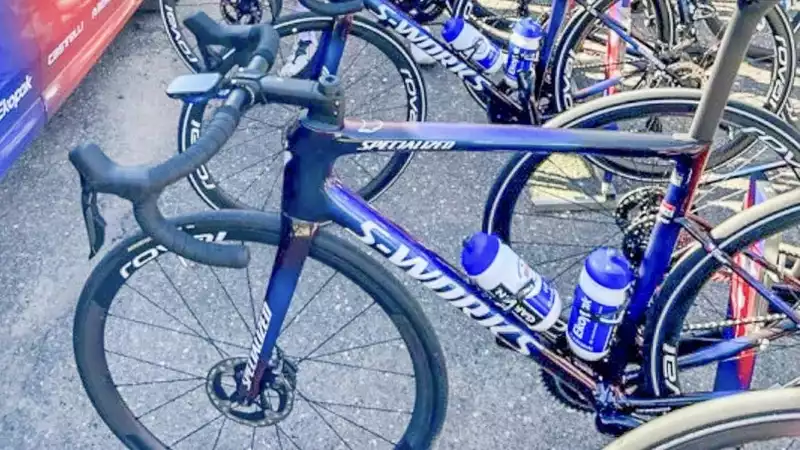We somehow knew that a new Specialized Tarmac was on the way. In a world where product cycles are regular enough to set the hands of a clock, the current Tarmac SL7 has been on borrowed time for a little while now; rumors of a new model have been flying around on WeightWeenies, with a few hints to whet our appetites.
And now, amidst an almost "oh, finally" mood among the relevant cycling tech community, some actual spy shots of the bike have emerged.
Naturally, this is all speculation, but we can at least read a few things about the new model from the images. Don't worry though, we'll have more on the headtube later.
For now, we can never draw any concrete conclusions since we only have a couple of pictures, but just by staring at these pictures and looking at old Specialized product catalogs, we can get some ideas about the design direction and inspiration.
Specialized was probably not the first to create a "race bike that does it all" (or, rather, it definitely wasn't, since everyone did it before aero bikes came along). Many other brands have coalesced around a more singular racing platform in recent years, most notably Canyon with its new Ultimate and Cannondale with its new Super Six Evo.
Perhaps anticipating future marketing, the new Tarmac (unless this is an entirely new machine) is expected to be lighter, stiffer, more aerodynamic, and more comfortable.
Also, if it is indeed called the Tarmac, Specialized will call it the Tarmac SL8, following the SL6 and SL7.
Even though the heyday of the aero bike is drawing to a close, improving aerodynamics remains a top priority, and this is most evident in the front end. The image, which appears to be a rendering rather than a photo, features what appears to be the new Roval Rapide cockpit unveiled in June. The fork blades are also deep and reminiscent of the now-obsolete Venge. But the most striking feature on the front end is that bulbous head tube, which has been getting deeper and deeper ever since the UCI relaxed its rules on tube depth.
Most brands tend to extend the tube backward, leaving a flat surface to cut through the wind. The new Tarmac, however, extends the headtube forward of the steerer and curves it. Not as extreme as Adam Blythe's Gold Genesis, but in the ballpark. The curved surface acts like a nose cone and may cut wind more effectively than a flat surface.
Moving backward, the main triangle is slightly thinner than on the SL7. The sloping top and down tube diameters are noticeably smaller, which is good for weight savings, but leaves less material to form awkward airflow. However, thanks to unpredictable elements such as the rider's legs, the center of the bike is tricky in terms of airflow. Much of the aerogain is gained at the leading edge, again suggesting that weight savings can be made at the rear, or at least to offset the bulkier front.
The seatpost also appears to be cleaner, perhaps to add comfort where it is easier to gain comfort. The rendered image is an inline model, but spy shots from the team camp suggest that a layback option is also planned. The location and design of the wedge clamp on the seat post seems to be a clear carryover from the SL7, but the saddle clamp appears to have been changed from a side-on bolt to a top-down version. The smaller seatpost creates a dilemma of where to put the Di2 battery on bikes not equipped with SRAM or the new Super Record EPS.
The rearmost part of the bike is the thinnest I have ever seen, both the seatstays and the chainstays. The seatstays are as thin as the new ultra-lightweight Factor O2 VAM, but the chainstays are also pencil shaped. This is because the new model is likely to be slightly more front-heavy. Even with the same geometry, this would affect handling. That's probably why the Srdal Quickstep team is testing with round bars and a conventional stem rather than an integrated cockpit (kudos to them for still being able to use this setup if they so choose).
Specialized has a habit of being fairly consistent in their geometry, but there seems to be a difference in fit with this new model, and the pros seem to need to dial it in before committing to the integrated Roval unit. Or perhaps the more expensive one-piece cockpit is for race bikes, and riders here are sticking to training bikes.
Finally, although there is no photo of the bike from the front, the thinner seatstays appear to improve tire clearance at the rear. The seatstays appear to be joined at the end of the bottom bracket shell, but are set equally wide and pinch in after passing through the tire. It is hard to imagine that they increased the rear tire clearance without increasing the front tire clearance. None of the Sourdal Quickstep teams seem to be running anything huge, but 32 mm of clearance would not be shocking.
That's all we can read from the two images for now. We will, of course, keep you posted as new information becomes available, but for now we can only eagerly await the release date and official news.
.

Comments